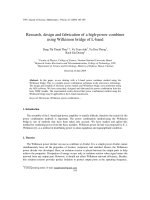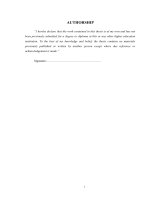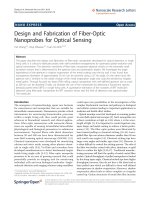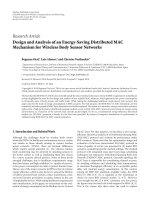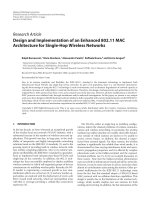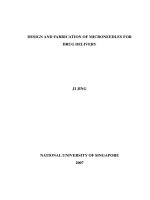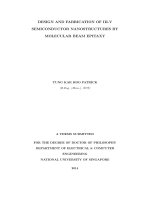titled design and fabrication of an automatic potato cutting machine
Bạn đang xem bản rút gọn của tài liệu. Xem và tải ngay bản đầy đủ của tài liệu tại đây (2.09 MB, 34 trang )
<span class="text_page_counter">Trang 1</span><div class="page_container" data-page="1">
<b>TABLE OF CONTENTS </b>
<b>PREFACE ... 3</b>
<b>CHAPTER 1 : INTRODUCTION TO THE PROJECT ... 4</b>
<b>1.1 Actual situation and Problem solving. ... 4</b>
<b>1.1.1Actual situation ... 4</b>
<b>1.1.2Problem solving. ... 4</b>
<b>1.2 Potential customers ... 5</b>
<b>1.3 Similar product. ... 5</b>
<b>1.3.1Square potato cutter (Semi – automatic potato cutting machine). ... 5</b>
<b>1.3.2Horizontal potato cutter. (Version 1) ... 6</b>
<b>1.3.3Horizontal potato cutter (Version 2) . ... 6</b>
<b>1.3.4Automatic potato cutting machine (120V – 2A) ... 7</b>
<b>1.3.5Automatic potato cutting machine (220V – 3A – 370W ) ... 8</b>
<b>1.4 Review and evaluation. ... 9</b>
</div><span class="text_page_counter">Trang 2</span><div class="page_container" data-page="2"><b>CHAPTER 4: EXPERIMENT AND RESULTS ... 31</b>
</div><span class="text_page_counter">Trang 3</span><div class="page_container" data-page="3"><b>PREFACE </b>
Today, the rapid advancement of human science and technology increasingly necessitates the evolution of automation to meet its demands. Automation is extensively cultivated across all sectors of the economy and social spheres, constituting a pivotal industry within industrial development.
Based on the facts, as a Mechatronics student, after four years of study, we've amassed substantial knowledge regarding automatic control systems. To reinforce and complement this knowledge while putting it into practical application, we undertook a graduation
<i><b>project titled "Design and Fabrication of an Automatic Potato Cutting Machine." Our </b></i>
endeavor involved constructing a model derived from a semi-automatic potato cutting machine commercially accessible in the market, which was then controlled using PIC16F877A.
Additionally, this project served as a foundational step in our journey toward establishing a comprehensive mechatronics system. It enabled us to formulate a methodology encompassing planning, information gathering, evaluation, and solution provision. Moreover, it facilitated the development of essential soft skills such as public speaking, document editing, presentation refinement, proficiency in foreign languages, and collaborative teamwork.
The team extends its heartfelt gratitude to the esteemed faculty members at the Faculty of Mechanical Engineering, Danang University of Science and Technology. We deeply appreciate the guidance and support provided by Mr. Do The Can and Mr. Anh Duc Pham throughout the execution of this project. While navigating the project, our team encountered instances of limited experience leading to occasional errors in knowledge. We kindly request your understanding and patience in overlooking these shortcomings.
Lam Anh Duc - 20CDTCLC3
</div><span class="text_page_counter">Trang 4</span><div class="page_container" data-page="4"><b>CHAPTER 1 : INTRODUCTION TO THE PROJECT </b>
<b>1.1 Actual situation and Problem solving. </b><b>1.1.1 Actual situation </b>
- In today's digital age, the consumption of fast food has become exceedingly prevalent. Among these options, French fries stand out as an indispensable dish when discussing fast food choices.
- French fries reign as the most popular dish crafted from potatoes. They are commonly served both as standalone snacks and as accompaniments to various meals. The meticulous preparation of French fries entails the intricate process of
<b>slicing potatoes into rectangular-shaped sticks before frying. </b>
- If done manually, this task demands a significant amount of human effort and time. Even when using a semi-automatic machine, it still requires human strength to operate the lever for each potato being cut. Given the substantial quantity of fries needed in restaurants, food outlets, large-scale kitchens, etc., we require a mechanism that minimizes human effort, delivers consistent output on demand, and is exceedingly user-friendly.
- That is why we conceived the idea of creating an automated potato chip cutting machine. Employing such a cutting machine will not only save time but also enhance productivity significantly when compared to conventional manual methods
<i><small>Figure 1.1 Potato </small></i>
<b>1.1.2 Problem solving. </b>
- The group proposed the design and production of an automatic potato cutting machine capable of replacing the manual task of cutting and slicing potatoes into consistent shapes without necessitating excessive effort, unlike conventional manual processing.
- The machine operates using standard household electricity, boasting ease of assembly and convenient mobility for users.
- Furthermore, our aim is to optimize costs to align with consumer needs, ensuring affordability, while also minimizing repair and maintenance expenses.
</div><span class="text_page_counter">Trang 5</span><div class="page_container" data-page="5"><b>1.2 Potential customers </b>
- The machine finds utility in various settings, including restaurants and resort hotels catering to international guests, fast food establishments offering a range of snacks, as well as food processing factories and households. Its value proposition extends across these diverse customer segments.
<b>1.3 Similar product. </b>
<b>1.3.1 Square potato cutter (Semi – automatic potato cutting machine). </b>
<i>Figure 1.2 Square potato cutter </i>
- Material: Inox and Platic - Product output: 1
- Productivity: Low
- Cutting method: Translation and hamade - Mass: Light
- Price: 800.000 VND - Productivity: 50 – 70 kg/h - Size: 10 x 20 x 40 (cm) - Direction: Straight
- Comment: The machine can cut vegetables and fruits with low productivity. The multi-purpose blade can cut a variety of objects. However, it requires human effort to operate the machine, so it is suitable for small households.
</div><span class="text_page_counter">Trang 6</span><div class="page_container" data-page="6"><b>1.3.2 Horizontal potato cutter. (Version 1) </b>
<i><small>Figure 1.3 Horizontal potato cutter. </small></i>
- Material: Inox - Product output: 1 - Productivity: Low
- Cutting method: Translation and hamade - Price: 1.900.000 VND
- Mass: Light
- Productivity: 70 – 100 kg/h - Size: 20 x 40 x 20 (cm) - Direction: Horizontal
- Comment: Stainless steel materials look more solid. The horizontal movement mechanism makes operation simple, and productivity is improved. However, productivity is still quite low because it still uses manual labor. The blade is also made from stainless steel, sharp, sturdy, and hygienic.
<b>1.3.3 Horizontal potato cutter (Version 2) . </b>
</div><span class="text_page_counter">Trang 7</span><div class="page_container" data-page="7"><i><small>Figure 1.4 Horizontal potato cutter (Version 2) </small></i>
- Material: Inox and Stell - Product output: 1
- Productivity: Low
- Cutting method: Translation and hamade - Mass: Light
- Productivity: 70 – 100 kg/h - Size: 20 x 40 x 20 (cm) - Price: 1.400.000 VND
- Comment: Like the product in the first version. Improved anti-slip base and longer handle to use less force.
<b>1.3.4 Automatic potato cutting machine (120V – 2A) </b>
<i><small>Figure 1.5 Automatic potato cutting machine. </small></i>
- Material: Inox and Stell - Product output: 1
- Productivity: Medium
- Cutting method: Translation and Automatic - Price: 2.400.000 VND
- Motor DC 120V – 3A - Productivity: 70 – 100 kg/h - Mass: Heavy (40 kg) - Size 30 x 60 x 40 (cm)
- Comment: The machine operates based on electrical energy, through the motor converting the rotary mechanism to a reciprocating mechanism that pushes the object to the cutting edge. Great productivity leads to guaranteed and better working quality, no longer using human strength to operate the cutting motion. - The material is sturdy and sturdy, the parts in contact with food are made entirely
from stainless steel to ensure hygiene.
</div><span class="text_page_counter">Trang 8</span><div class="page_container" data-page="8">- However, the size is large, and the price is also quite high, suitable for restaurants and food production facilities.
<b>1.3.5 Automatic potato cutting machine (220V – 3A – 370W ) </b>
<i><small>Figure 1.6 Automatic potato cutting machine (220V – 3A – 370W ) </small></i>
- Material: Inox and Stell - Product output: 1
- Productivity: Medium
- Cutting method: Translation andu Automatic - Motor DC 220V – 3A – 370W
- Productivity: 300 - 500 kg/h - Mass: Heavy (60 kg)
- Size 88 x 32 x 52 (cm)
- Comment: The 3A370W sweet potato frying machine is equipped with 3 sharp stainless-steel knives, which can slice high-hardness fruits and vegetables such as sweet potatoes, kohlrabi, and carrots. The 3 knife molds have cutting eyes of 6 x 6mm, 9 x 9mm and 13 x 13mm, respectively, helping users flexibly adjust the size of vegetables that need to be cut.
- The 3A370W sweet potato cutting machine is very simple to use, with 2 cutting modes: automatic or manual control. The maximum material size is 80x80mm. For some hard tubers, cut into 40-50mm short pieces, using a 13x13mm mold. - The 3A370W sweet potato cutting machine has strong pressure and sharp cutting
blades so the fruits and vegetables are not crushed or broken after cutting. Corresponding to each knife mold, users will receive products of uniform size,
</div><span class="text_page_counter">Trang 9</span><div class="page_container" data-page="9">beautiful, high quality, with a productivity of 300 - 500kg/hour, saving maximum time and effort in preliminary processing.
- Besides the automatic sweet potato and square potato cutting machine, 3A also introduced and brought a semi-automatic potato cutting machine with an extremely compact design, with a productivity of 80 - 100kg/hour suitable for those who Individuals who are selling snacks such as sweet potato shakes, kfc potatoes, dried vegetable processing establishments, collective kitchens…
<b>1.4 Review and evaluation. </b>
- In general, all the above-mentioned machines can fulfill the requirements of cutting and slicing old vegetables and fruits. In addition, there are machines that are versatile in cutting materials and can cut many types of old vegetables and fruits. Materials from high-cost machines are also of better quality, ensuring food hygiene and safety as well as market aesthetics.
- At the same time, the individual group asks for permission to have some individual assessments of the pros and cons to use as a premise to develop the product in the most optimal and appropriate direction.
- Advantages:
+ Diverse design can perform the task of slicing potatoes.
+ Materials are also diverse, especially in high-priced machines, the better the material.
+ There are some machines that can diversify cutting objects such as fruits and vegetables.
- In general:
+ The above machine is almost finished very well.
+ Focus on solving the problem of automatic fuel billet feeding. + Optimize structure and motivation to increase productivity. + Reduce design details to save costs.
</div><span class="text_page_counter">Trang 10</span><div class="page_container" data-page="10"><b>CHAPTER 2 : SYSTEM DESIGNS </b>
<b>2.1 Mechanical system. </b><b>2.1.1 Transmission. </b>
<b>2.1.1.1 Dynamic diagram. </b>
<i><small>Figure 2.1 Dynamic diagram </small></i>
<b>2.1.1.2 Transmission principle. </b>
- Fuel supply department:
+ After being peeled and washed, the vegetables will be dried and poured into the embryo feeder for cutting.
- Translational knife cutting plan:
+ Fixed blade. The reciprocating mechanism makes the connecting rod move. + This movement is transmitted to the knife and helps the cutting board push the
ingredients forward to the blade and cut them. - The selected transmitter is:
+ Screw - nut transmission.
<b>2.1.2 Machine elements. 2.1.2.1 Machine details. A. Force plate. </b>
</div><span class="text_page_counter">Trang 11</span><div class="page_container" data-page="11"><i><small>Figure 2.2 Lining </small></i>
- Material: Stell CT45 - Quantity: 1
<b>B. Left flange. </b>
<i><small>Figure 2.3 Left flange </small></i>
</div><span class="text_page_counter">Trang 12</span><div class="page_container" data-page="12">- Material: Stell CT45 - Quantity: 1
<b>B. Right flange. </b>
<i><small>Figure 2.4 Right flange. </small></i>
- Material: Stell CT45 - Quantity: 1
<b>C. Lead Screws, Nuts. </b>
<i><small>Figure 2.5 Nut – Crew. </small></i>
</div><span class="text_page_counter">Trang 13</span><div class="page_container" data-page="13">- Material: Stell CT45 - Quantity: 1
<b>D. Sliding plate. </b>
<i><small>Figure 2.6 Slide. </small></i>
- Material: Stell CT45 - Quantity: 1
<b>E. Push bar. </b>
<i><small>Figure 2.7 Push bar. </small></i>
- Material: Stell CT45 - Quantity: 1
</div><span class="text_page_counter">Trang 14</span><div class="page_container" data-page="14">- After designing the overview, we proceed to design each detail
<i><small>Figure 2.8 Mechanical model overview </small></i>
- After designing the overview, we proceed to design each detail
</div><span class="text_page_counter">Trang 15</span><div class="page_container" data-page="15"><b>2.2 Electronic systems 2.2.1 Electronic motor </b>
<b>2.2.1.1 Calculate the transmission mechanism. </b>
- Target:
+ Estimated productivity: 100 - 150 kg/h. + Weight of 1 tuber: 300 grams.
+ To achieve yield, you need to cut: 350 - 400 tubers. + The cycle of cutting 1 fruit takes: 10.2 seconds. - Parameters:
+ Materials: C45 steel. + Axial force: 800 - 1000 N
+ Length of lead screw: Lb = 1000 mm + Maximum speed: V = 0.1 m/s
+ Friction coefficient of nut: 𝜇o =0.03 + Lead screw pitch: ∆l = 0.02 mm + External force: Fa = 29.4
+ Sliding friction coefficient: 𝜇 = 0.04 + Lead screw diameter: D = 25 mm + Lead screw slider: Pb = 10 mm
Nm = <sup>60 ×𝑉</sup><sup>𝑙</sup>
<small>𝑃</small><sub>𝑏</sub> = <sup>60 ×0.1</sup>
<small>10.10−3</small> = 600 (r/p) - Static force:
F = Fa + mg (sin𝜃 + 𝜇𝑐𝑜𝑠𝜃 )
= 29.4 + 50 × 9.8 (𝑠𝑖𝑛0° + 0.04 × 𝑐𝑜𝑠0°) = 49 (N)
- Operating torque:
𝑇<sub>𝑙</sub> = <sup>𝐹 × 𝑃</sup><sup>𝑏</sup>
<small>2𝜋 ×𝑛</small> + <sup>𝜇</sup><sup>𝑜 × 𝐹𝑜 ×𝑃𝑏</sup>
<small>2𝜋</small> = 0.09 ( Fo = 1/3 F ) - Moment of inertia:
𝐽<sub>𝑏</sub> = <sup>𝜋</sup>
<small>32</small> × 𝜌 × 𝐿<sub>𝑏</sub>× 𝐷<sub>𝑏</sub><sup>4</sup> = 3.03 × 10<sup>−4</sup> (𝑘𝑔𝑚<sup>2</sup>) - Moment of the moving mechanism system:
J = 𝐽<sub>𝑏</sub> + 𝐽<sub>𝑚</sub> = 4.3 × 10<small>−4</small> (𝑘𝑔𝑚<small>2</small>) - Safety factor (1.5):
𝑇<sub>𝑙</sub>’ = 0.135 (Nm)
</div><span class="text_page_counter">Trang 16</span><div class="page_container" data-page="16"><i><small>Figure 2.9 Time diagram </small></i>
- Preliminary requirements to choose an engine:
+ Engine speed (600r/min), Operating moment 0.135 (Nm), Moment of inertia 4.3 × 10<sup>−4</sup> (𝑘𝑔𝑚<sup>2</sup>)
+ Safety factor 1.5
+ Moment of the moving mechanism system: 1.5 x Tl
<b>- Motor DCM555 </b>
⚫ Voltage: 24VDC ⚫ Speed reducer: 20:1
⚫ Mailbox parameter speed: 600rpm ⚫ Capacity 17W
+ Automatic DC motor. - Schematic Capture.
</div><span class="text_page_counter">Trang 17</span><div class="page_container" data-page="17"><i><small>Figure 2.10 Schematic Capture. </small></i>
<b>2.2.2.2 PCB design </b>
+ PIC16f877A + Domino, header + Button
</div><span class="text_page_counter">Trang 18</span><div class="page_container" data-page="18"><b>2.2.2.3 3D Visualzer </b>
+ Proteus software will simulate and show 3D images of the circuit, based on which we can arrange components in convenient locations for external wiring.
<i>Figure 2.12 3D Visualizer. </i>
<b>2.3 Control systems. </b>
<b>2.3.1 Algorithm Flowchart </b>
</div><span class="text_page_counter">Trang 19</span><div class="page_container" data-page="19"><i><small>Figure 2.13 Flowchart </small></i>
</div><span class="text_page_counter">Trang 20</span><div class="page_container" data-page="20">#include <codepbl.h>
#define LCD_ENABLE_PIN PIN_C5
#define LCD_RS_PIN PIN_D3
#define LCD_RW_PIN PIN_C4
#define LCD_DATA4 PIN_D4
#define LCD_DATA5 PIN_D5
#define LCD_DATA6 PIN_D6
#define LCD_DATA7 PIN_D7
#include <lcd.c> /*INPUT*/ #define BT_START PIN_B4 while(TRUE) {
while (option == 0) {
lcd_putc('\f'); lcd_gotoxy(1,1); lcd_putc("HAND CONTROL"); delay_ms(500); control_motor_manual (); if(!input(BT_STOP)) {
delay_ms(20); motor_stop();
</div><span class="text_page_counter">Trang 21</span><div class="page_container" data-page="21">#define BT_STOP PIN_B1 #define BT_TIEN PIN_B2 #define BT_LUI PIN_B3 #define BT_MODE PIN_B0 #define CTHT1 PIN_B5 //note #define CTHT2 PIN_B6 //note #define LED1 PIN_D0
#define LED2 PIN_D1 #define LED3 PIN_D2 /*OUTPUT*/
#define motor1 PIN_C1 #define motor2 PIN_C2 void control_motor_manual (); void motor_R();
void motor_L(); void motor_stop(); void reset_dc(); /*NGATNGOAI*/ char option = 0; #INT_EXT
void external_interrupts(void) {
if(!input(BT_MODE)) {
delay_ms(20); option ++; if(option == 2) {
option = 0; delay_ms(100); }
} }
void main() {
set_tris_a(0XFF); set_tris_b(0xFF); set_tris_c(0); set_tris_d(0); set_tris_e(0xF); port_b_pullups(1); output_low(LED1);
} }
while (option == 1) {
lcd_putc('\f'); lcd_gotoxy(1,1);
lcd_putc("AUTOMATIC"); delay_ms(500);
output_high(LED3);
if(!input(CTHT1)){ delay_ms(20); motor_L();
}
else if(!input(CTHT2)){ delay_ms(20);
motor_R();
}
else if(!input(BT_STOP)) {
delay_ms(20); motor_stop();
} } } }
//====CHUONG TRINH CON======= void control_motor_manual ()
{
if(!input(BT_TIEN)) {
delay_ms(20); motor_R();
}
else if (!input(BT_LUI))
</div>
